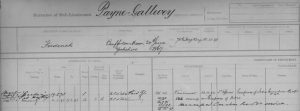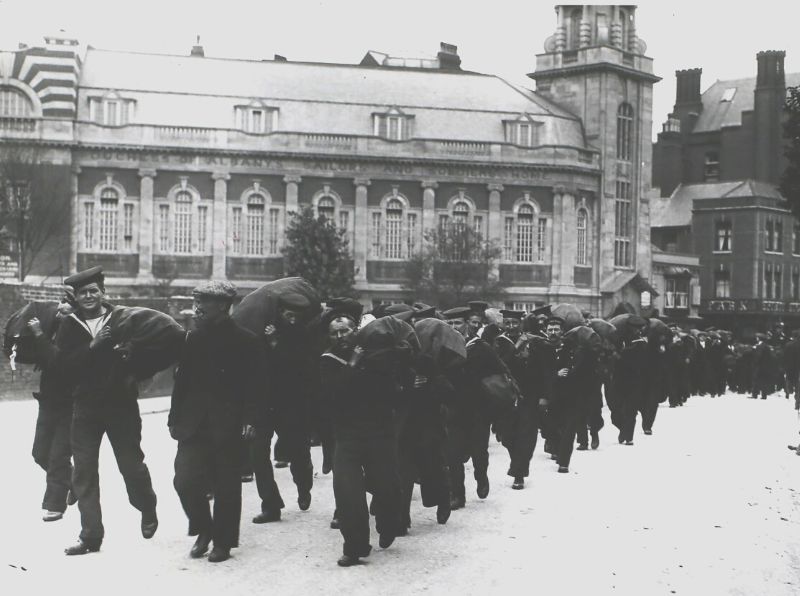Britain has a strong maritime tradition, and you may have navy ancestors waiting to be discovered. But how do you uncover details of your ancestors’ service with the Royal Navy, and what can you learn about their time at sea? We’ve compiled a list of 7 essential navy collections available on Forces War Records to help you make meaningful discoveries.
This collection is a great place to start researching your navy ancestors, providing a fascinating insight into a sailor’s navy career. Before 1853, service records tracking a seaman’s movements were not kept.
Records in this collection vary over the decades: early entries generally indicate your ancestor’s rank (known as rating), the ship they served aboard, when their service commenced and how long they enlisted for. Later entries note all the vessels your ancestor served aboard, their promotions and personal information, like their date and place of birth, occupation and physical description. This collection is particularly valuable for piecing together your ancestor’s naval service during WWI.

FWR Tip: You may notice your navy ancestor served on two ships at once. The ship in brackets was the seagoing ship, while the ship not in brackets was the accounting base.
Medal records can be a vital source for family historians, offering useful military and genealogical information. Not only is it interesting to discover the medals your ancestor was entitled to, adding further context to their service, but the details held within could help you search other military records.
This collection primarily contains medal rolls for seamen who served during WWI, noting the recipient’s name, rating, number, the medals they were entitled to, and how they were issued. These are key details to help you identify their service record.
FWR Tip: The following letters represent different WWI medals in the rolls: St = Star (usually the 1914-15 Star. If the seaman was entitled to the 1914 Star, it is usually written as ‘1914 St’. V = Victory Medal and B = British War Medal.
The Royal Naval Volunteer Reserve (RNVR) was formed in 1903 to provide a reserve of trained seamen who could be called on during times of war. On joining, the civilian volunteers committed to drill and annual training.
The collection contains entries for officers and ratings of the RNVR. Similar to the Royal Navy service records, this collection allows you to establish the different ships your ancestor served aboard and the respective dates, in addition to other helpful military and genealogical details. You can then research the ships your navy ancestors served aboard and establish the activities and battles they were engaged in.
The Royal Naval Reserve differed from the RNVR in that it comprised trained Merchant Seamen. Established in 1859, it would bolster the Royal Navy during times of war. Entries in this collection detail the officer’s date and place of birth and their attendance at drill – a pre-requisite of joining the reserve. They also note periods of engagement at sea, the name of the ship and their capacity aboard the ship subsequent to joining the reserve. This collection allows you to piece together the voyages your navy ancestors took, where they were sailing, and when and where they were discharged after each journey. Any service with the Royal Navy is also noted.

The Royal Navy Long Service and Good Conduct Medal was introduced in 1831 and was awarded to non-officers. The demanding criteria initially required 21 years of service and good conduct but was later reduced to ten years and then back up to 15. A clasp to the medal was introduced during the reign of King George V and was awarded for an additional fifteen years of service.
Knowing your ancestor was eligible for the medal adds another layer to their military story, while the clues held within the rolls could help you search other naval collections. Entries often detail the medal awarded, the date and the years served. Their rating and the ship they served aboard often feature, too.
Medical officers serving in the Royal Navy were required to submit detailed records of their patients’ health, treatment and survival rates to the Admiralty throughout the war. The ledgers in this collection provide a compelling insight into the ailments and injuries sustained by our navy ancestors during WWI. The details found in this collection are unlikely to feature in the sailor’s service record, making it an insightful resource for family historians.
Typical entries note the person’s age, rating, ship, fleet or station, ailment, date of admission and date of discharge back to duty. These are key details to add to the timeline of your ancestors’ naval service.
If your ancestor was an officer with the Royal Navy, try searching the Navy Lists. Published monthly, bimonthly, and quarterly, these records often reveal the ship your ancestor was serving aboard, their rank and their seniority date (the date of promotion to the rank displayed). Helping you to plot your ancestor’s career progression, the navy lists are especially valuable if you are not in possession of the officer’s service record. They also serve as confirmation of your ancestor’s service with the navy. Be sure to consult the early pages of each publication for a key corresponding to frequently used abbreviations and symbols.
FWR Tip: Names appear in the navy lists in different groupings. Below is just one example of how your navy ancestors may appear in the lists:

Cover image: © Hulton Archive/Getty Images


